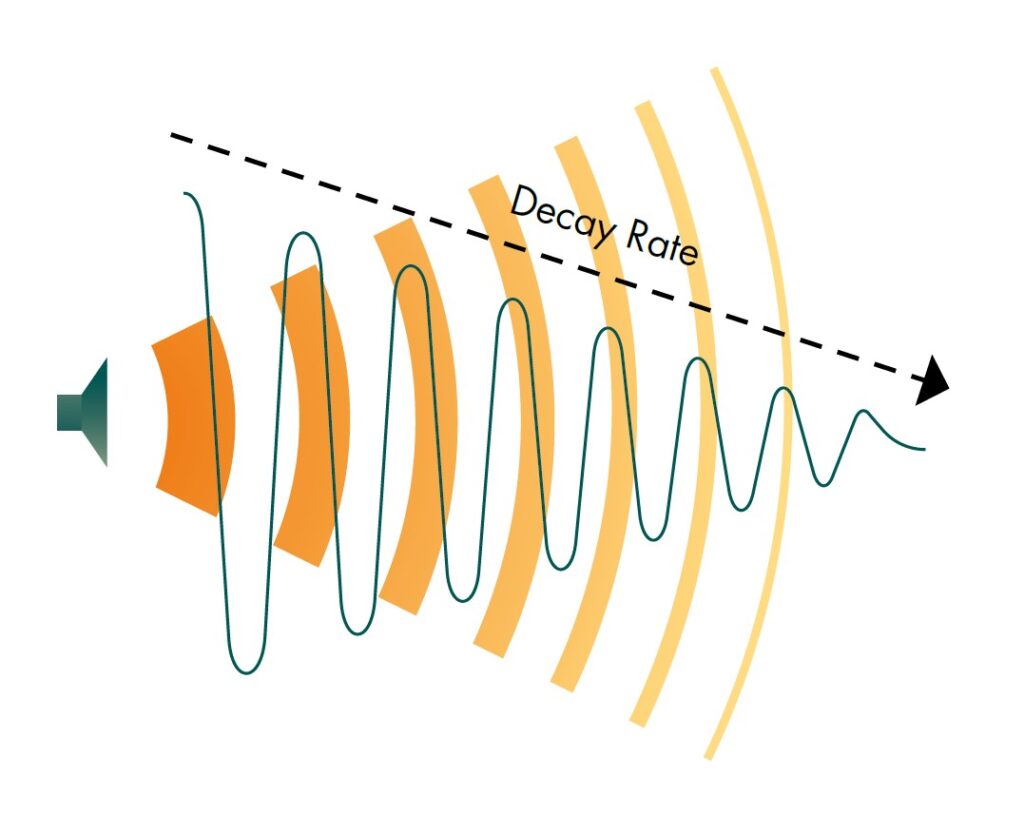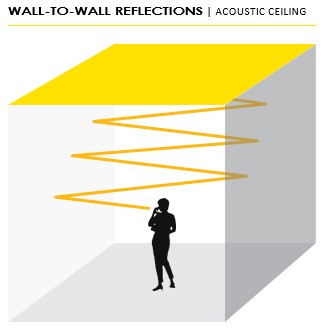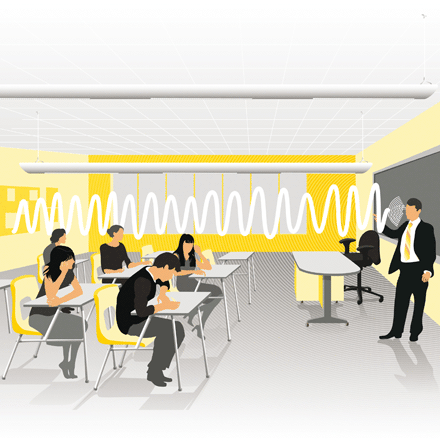
Room acoustics is more nuanced than what is specified in most national requirements and regulations. If you, for example, wish to create a good sound environment in an open office environment, it is often better to consider multiple parameters and not merely the absorption area or reverberation time. The four primary technical basic terms that you should work with are reverberation, speech intelligibility, sound strength, and sound propagation. Together, these parameters describe the acoustic comfort of a room.
In many circumstances, it is advantageous to quality-assure a given design via multiple objective parameters. By specifying these several acoustic parameters in the building program, you can ensure that any building project can live up to its purpose from the first day it is taken into use.
Reverberation (ISO 3382-1 & 2)
Reverberation is the most basic acoustic parameter and characterises the time during which the sound waves are reflected between surfaces of an enclosed space. Churches, for example, always have a relatively long reverberation. The reverberation time is specified for several frequency bands. It depends on the size, shape, number, types of surfaces, object present etc. in the room. Read more about reverberation in this basic introduction to room acoustics.
Speech intelligibility (ISO 3382-1 & EIC 60268-16)
Speech intelligibility characterizes how clearly speech is perceived. In a room with long reverberation times and disturbing background noise, it may be difficult to understand speech.
Sound waves traveling directly from source to receiver are referred to as direct sound. It is followed by early reflections from the nearest surfaces. The early reflections that reach the listener within 50 milliseconds are perceived as integrated with the direct sound and thus have a positive effect on speech intelligibility. The reflections that reach the ear after this point are disruptive and degrade speech intelligibility.
The descriptor Speech Clarity or C50 quantifies the difference between sound energy in early and late reflections. It is expressed in dB where a negative value connotes poor speech clarity, positive values connote acceptable clarity, and values above 5 dB connote excellent speech clarity.
Another measure for voice transmission is Speech Transmission Index or STI. It quantifies how large a percentage of speech is understandable. STI = 1 corresponds to 100 % understanding, STI = 0.75 corresponds to 75 %, etc.
Sound Strength (ISO 3382-1)
Sound Strength or G is a measure of how much the acoustics of a room contributes to the noise levels and is denoted in dB.
Sound Strength quantifies the difference in noise levels between a given room and an anechoic chamber with the same sound source. This parameter thus represents how much louder the sound levels will we be in a room due to sound reflections from hard surfaces.
It is important to consider the Sound Strength in rooms where particularly noisy activities will take place since a high G value could imply that the noise level in the room could easily escalate. In addition to this, Sound Strength is especially important to consider in small rooms with low reverberation time. A room may have a short reverberation time and still contribute significantly to the noise levels and thus will often not be treated adequately if only evaluated only in terms of reverberation time.
Sound Propagation (ISO 3382-3, 14257 & 22955)
In large or elongated spaces, such as corridors or open environments, the requirements for reverberation time or absorption are often not sufficient to secure a good sound environment. In fact, in many open environments reverberation times can differ to a degree to which it is not indicative of the actual quality of the sound environment. Much more relevant descriptors are the Spatial Decay Rate, DL2 or Spatial Decay Rate of Speech or D2,S. These descriptors specify the reduction in sound pressure when the distance to the source is doubled. Therefore the higher DL2 or D2,S value, the better.
Another way of evaluating sound propagation in an open office is the A-weighted SPL of speech at 4 m, or LP,A,S,4 m.. It is defined as the nominal A-weighted sound pressure level of normal speech at a distance of 4 m from the sound source. LP,A,S,4 m is obtained using a linear regression line from the spatial sound distribution of the A-weighted sound pressure level (SPL) of speech. The lower the value, the better the sound environment.
ISO 22955 has added a new technical descriptor for sound propagation called the in situ attenuation of a-weighted speech or DA,S. Unlike many other room acoustic descriptors, DA,S denotes a difference in sound level between a sound source and a receiver. Several DA,S values could therefore be relevant to evaluate spaces where several activities with different acoustic needs are to be carried out. The precise definition from ISO 22955 is as follows:
“Difference, in decibels, between an A-weighted speech source spectrum at 1 m from an omni-directional source in the free field and the A-weighted sound pressure level at a reception point.”
The most effective way of reducing sound propagation is, through screening with acoustic materials like free-standing panels.
How to improve acoustic privacy in open offices with screens
International & American standards for indoor acoustic comfort




